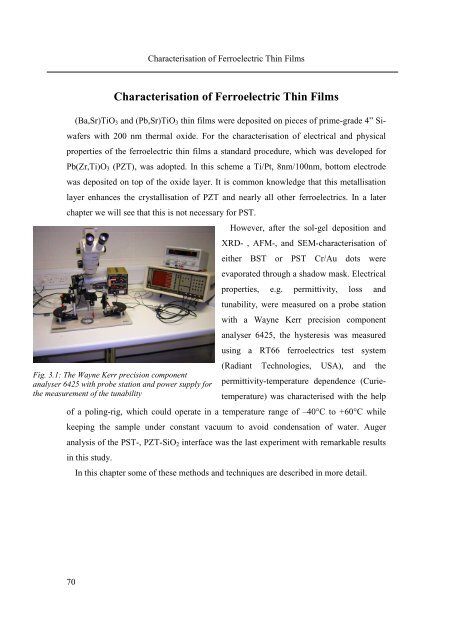PhD Thesis Arne Lüker final version V4 - Cranfield University
PhD Thesis Arne Lüker final version V4 - Cranfield University
PhD Thesis Arne Lüker final version V4 - Cranfield University
You also want an ePaper? Increase the reach of your titles
YUMPU automatically turns print PDFs into web optimized ePapers that Google loves.
70<br />
Characterisation of Ferroelectric Thin Films<br />
Characterisation of Ferroelectric Thin Films<br />
(Ba,Sr)TiO3 and (Pb,Sr)TiO3 thin films were deposited on pieces of prime-grade 4” Si-<br />
wafers with 200 nm thermal oxide. For the characterisation of electrical and physical<br />
properties of the ferroelectric thin films a standard procedure, which was developed for<br />
Pb(Zr,Ti)O3 (PZT), was adopted. In this scheme a Ti/Pt, 8nm/100nm, bottom electrode<br />
was deposited on top of the oxide layer. It is common knowledge that this metallisation<br />
layer enhances the crystallisation of PZT and nearly all other ferroelectrics. In a later<br />
chapter we will see that this is not necessary for PST.<br />
Fig. 3.1: The Wayne Kerr precision component<br />
analyser 6425 with probe station and power supply for<br />
the measurement of the tunability<br />
However, after the sol-gel deposition and<br />
XRD- , AFM-, and SEM-characterisation of<br />
either BST or PST Cr/Au dots were<br />
evaporated through a shadow mask. Electrical<br />
properties, e.g. permittivity, loss and<br />
tunability, were measured on a probe station<br />
with a Wayne Kerr precision component<br />
analyser 6425, the hysteresis was measured<br />
using a RT66 ferroelectrics test system<br />
(Radiant Technologies, USA), and the<br />
permittivity-temperature dependence (Curie-<br />
temperature) was characterised with the help<br />
of a poling-rig, which could operate in a temperature range of –40°C to +60°C while<br />
keeping the sample under constant vacuum to avoid condensation of water. Auger<br />
analysis of the PST-, PZT-SiO2 interface was the last experiment with remarkable results<br />
in this study.<br />
In this chapter some of these methods and techniques are described in more detail.

















